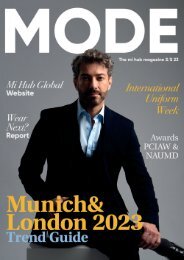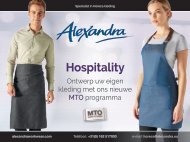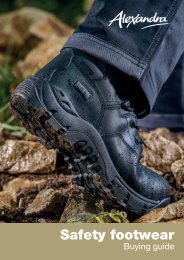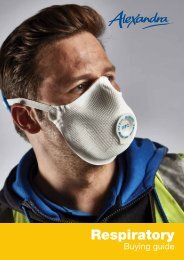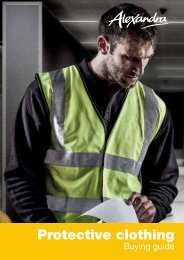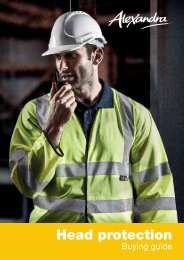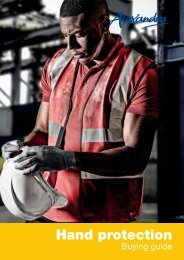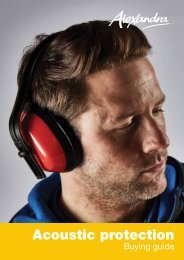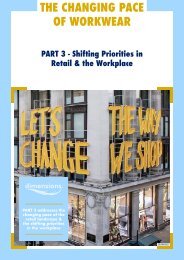The Changing Pace of Workwear Pt 2
Create successful ePaper yourself
Turn your PDF publications into a flip-book with our unique Google optimized e-Paper software.
THE CHANGING PACE<br />
OF WORKWEAR<br />
PART 2 - Future Technologies & Sustainability<br />
PART 2 explores the<br />
different technologies<br />
& sustainable<br />
innovations <strong>of</strong><br />
the future<br />
...coming soon PART 3<br />
will address how<br />
COVID-19 has effected<br />
the retail landscape &<br />
the shifting priorities in<br />
the workplace<br />
EUROFIBER
WGSN<br />
Coronaviru<br />
<strong>The</strong> Impact<br />
Our Planet<br />
Throughout this repor<br />
global drivers and key<br />
action for future succe<br />
sustainability and re<br />
for the climate is no lo<br />
critical consideration f<br />
consumers are prior<br />
and conscious corpor<br />
than ever...<br />
‘Futurewear’:<br />
<strong>The</strong> Big Ideas<br />
In 2020/21we have been through numerous global<br />
shutdowns, but by 2023 companies and consumers<br />
will be opening up to new strategies, innovations and<br />
priorities. In an era <strong>of</strong> uncertainty, it’s all about the<br />
4 C’s: Connection, Conservation, Communication<br />
and Community. Brands will find new and smart<br />
ways <strong>of</strong> connecting, communicating and building<br />
communities with consumers, then conserving<br />
resources will be imperative. In Part 2 <strong>of</strong> <strong>The</strong><br />
<strong>Changing</strong> <strong>Pace</strong> <strong>of</strong> <strong>Workwear</strong>, we will discuss how<br />
companies are already starting to do this with new<br />
technologies and sustainable innovations.<br />
2
...Despite a turbulence from COVID-19,<br />
sustainability is still a focus and will be<br />
even more so, considering there is an<br />
awareness <strong>of</strong> the negative but also the<br />
positive effects on the environment<br />
due to the pandemic.<br />
We have seen a reduction in Green<br />
House Gas emissions in the EU compared<br />
to 2019, however these reductions could<br />
be short lived as strict lockdown<br />
restrictions are lifted, according to the<br />
European Environment Agency.<br />
Along with a reduction in air pollution,<br />
we have also seen a reduction <strong>of</strong> water<br />
pollution, noise pollution and ecological<br />
restoration; where wild animals moved<br />
into urban areas as people stayed<br />
indoors.<br />
s & Clothing:<br />
on<br />
PANGAIA<br />
However, there have also been<br />
negative environmental impacts; as<br />
discussed briefly in Part 1, the<br />
pandemic has led to a sudden surge in<br />
global demand for personal<br />
protective equipment (PPE), including<br />
masks, gloves, gowns and bottled hand<br />
sanitiser, etc. This has caused a sudden<br />
rise <strong>of</strong> hazardous waste which has<br />
become a significant challenge for the<br />
local waste management authorities.<br />
t we will discuss some <strong>of</strong> the<br />
strategies that businesses can<br />
ss. Firstly, let’s take a look at<br />
generation; adapting to care<br />
nger a strategy; it’s a<br />
or long-term growth because<br />
itising conscious consumption<br />
ate social responsibility more<br />
Additionally, there has been an increase<br />
in the amount <strong>of</strong> waste packaging, some<br />
<strong>of</strong> which can be recycled but a lot is<br />
single use plastic. This is the result <strong>of</strong> mass<br />
online shopping; the likes <strong>of</strong> fashion<br />
retailers Asos and Boohoo saw sales rise<br />
by 40 per cent in the last four months <strong>of</strong><br />
2020, also many restaurants and cafés<br />
have moved to <strong>of</strong>fering take aways<br />
using single use plastic containers.<br />
So how can we regenerate post<br />
pandemic?<br />
3
MARIE CLAIRE<br />
WGSN<br />
THE CONVERSATION<br />
Environment & Climate Action:<br />
“From Urgency to Emergency”<br />
iNEWS<br />
“<strong>The</strong> pandemic has upended the lives <strong>of</strong> billions and been disastrous for the already<br />
vulnerable, exposing the inequalities <strong>of</strong> the world, and the fragility <strong>of</strong> the system<br />
that the fashion industry operates in,” says Kerry Bannigan, founder <strong>of</strong> the<br />
Conscious Fashion Campaign (Drapers).<br />
Clothes are an everyday necessity and a form <strong>of</strong> self expression. But according to<br />
the UN, the fashion industry is the second most polluting industry globally. In the<br />
UK alone an estimated 350,000 tonnes <strong>of</strong> garments end up in landfill each year.<br />
4
VIVIENNE WESTWOOD<br />
NYC FASHION WEEK - NEW YORK TIMES<br />
From worsening seasons, severe droughts, increased wildfires and mass waste,<br />
scientific evidence shows that collectively we need to do more to tackle climate<br />
change. Companies/brands/corporations need to understand and implement<br />
sustainable solutions that will align with consumers’ values. To not take a<br />
sustainable stance is to be complicit, we need to invest now, or pay later. At<br />
Dimensions, we continually look at new innovations for sustainable solutions.<br />
ECOALF<br />
FASHIONISTA.COM<br />
5
6<br />
REPURPOSE<br />
ECOTEXTILE.COM<br />
One key future strategy is to work towards a closed loop system. Many<br />
brands are already working towards this; H&M revealed a new in-store<br />
garment-garment knitwear recycling system, Looop, in Stockholm. <strong>The</strong><br />
machine transforms old garments into new pieces in an 8 step process<br />
from cleaning and shredding to spinning yarn and knitting (without<br />
water and toxic chemicals). Fast Fashion Giant Inditex aims to send<br />
nothing to landfill by 2023 from all it’s divisions and Nestlé is investing<br />
$30m in the Closed Loop Leadership Fund.<br />
REINVENT, RESALE<br />
“LOOOP” H&M<br />
Recycled Polyester (rPET) degrades<br />
each time it is heated to repurpose so<br />
it can’t be used infinitely. Water, dye,<br />
energy inputs and chemical releases<br />
also need to be monitored as this can still<br />
be polluting. It is arising garment togarment<br />
recycling that is advantageous<br />
and will <strong>of</strong>fer more potential for<br />
circularity in the future.<br />
CLOSED LOOP<br />
WGSN<br />
“LOOOP” H&M<br />
H&M
CIRCULOSE® is new natural material that<br />
helps close the loop, made out <strong>of</strong><br />
Cotton textile waste.<br />
CIRCULOSE®<br />
FINISTERRE<br />
Out <strong>of</strong> 53 millions tonnes <strong>of</strong> garments<br />
produced each year, 73% are sent to<br />
landfill or are incinerated and <strong>of</strong> all new<br />
clothing made, less than 1% <strong>of</strong> material<br />
used comes from recycled sources. (Ellen<br />
MacArthur Foundation).<br />
#closetheloop the<br />
3 R’s: Repurpose,<br />
Reinvent, Resale<br />
WGSN<br />
Martin Stuchtey, from SystemIQ<br />
forecasts that if we undermanage and<br />
underreact to threats that are depleting<br />
natural capital and the planet’s<br />
ability to regenerate itself, it will hinder<br />
future economic success. What works<br />
for us now, will not work for an<br />
expanding population. <strong>The</strong> take-makewaste<br />
linear economy needs to change<br />
to become circular; “by designing out<br />
waste and pollution, keeping<br />
products and materials in use, and<br />
regenerating natural systems we can<br />
reinvent everything.”<br />
ELLEN MACARTHER FOUNDATION<br />
EVERLANE<br />
7
PANGAIA - FLWRDWN<br />
PANGAIA - FLWRDWN<br />
PATAGONIA - ACTION WORKS<br />
PATAGONIA - WORN WEAR<br />
Repurpose,<br />
Reinvent, Resale:<br />
Key Brand Initiatives<br />
Sustainability-conscious consumers will<br />
prevail and behaviours are already<br />
changing, this is beginning to challenge<br />
traditional retail and business models; buy<br />
back or subscription schemes are making<br />
recycling easier and enabling stress free<br />
circular shopping. Here is an example <strong>of</strong><br />
what three key brands are doing:<br />
MUD JEANS<br />
8
PATAGONIA ACTION WORKS:<br />
Links people to the planet, connecting<br />
individuals with environmental groups to<br />
take action on the most pressing global issues.<br />
WORN WEAR:<br />
Up-cycled Patagonia clothing is sold online,<br />
customers can exchange old Patagonia clothes<br />
for vouchers. Repairs are also made on the<br />
road.<br />
1% FOR THE PLANET:<br />
An alliance <strong>of</strong> businesses who pledge 1% <strong>of</strong><br />
annual sales for the preservation and<br />
restoration <strong>of</strong> the natural environment.<br />
More than $270 million has been raised.<br />
Patagonia also use Regenerative Organic<br />
Cotton & 68% <strong>of</strong> their product is made<br />
from recycled materials!<br />
<strong>The</strong>y aim to be<br />
carbon neutral<br />
by 2025!<br />
PATAGONIA - 1% FOR THE PLANET<br />
CREATING A WORLD WITHOUT WASTE:<br />
MUD Jeans are made with up to 40%<br />
recycled cotton and organic cotton. Per jean,<br />
they use 92% less water than usual and 70%<br />
less CO2. Users can choose to buy or lease<br />
for €9,95 per month (inc free repairs). <strong>The</strong><br />
jeans can then be swapped for a new pair.<br />
When buying or leasing, the jeans can be<br />
returned for a voucher.<br />
FAIR FACTORIES & POSITIVE ACTIVISM:<br />
<strong>The</strong>y work with selected manufacturers that<br />
ensure the wellbeing and fair pay <strong>of</strong> staff.<br />
<strong>The</strong>y have a mission to educate and aim to<br />
produce jeans from 100% recycled cotton.<br />
MUD JEANS CIRCULAR MODEL<br />
A MATERIALS SCIENCE COMPANY EST. 2018:<br />
<strong>The</strong>y design product and develop materials<br />
such as C-FIBER (100% biodegradable and<br />
water saving, made from eucalyptus pulp<br />
and seaweed powder), FLWRDWN<br />
(insulation developed from sustainably sourced<br />
wildflowers and maize biopolymer) grape<br />
leather, recycled cotton and recycled wool.<br />
IMPACT INITIATIVES:<br />
PANGAIA have raised money for their Bee<br />
<strong>The</strong> Change Fund and planted over 400,000<br />
trees for their Tomorrow Tree Fund, they’ve<br />
also raised and donated over $100k to<br />
humanitarian organisations and charities.<br />
9<br />
PANGAIA
Push For<br />
Progress:<br />
ELLEN MACARTHER FOUNDATION<br />
Future Driver:<br />
Regenerative<br />
Change<br />
What is Regenerative<br />
Agriculture? It’s a farming<br />
practice that actively improves<br />
environmental conditions such as<br />
restoring soil quality and the<br />
balance <strong>of</strong> biodiversity, it absorbs<br />
carbon and minimises impact.<br />
Businesses that push for progress<br />
in regenerative agriculture will<br />
be in a strong position for the near<br />
future. Products that are designed<br />
to do less harm - starting from the<br />
soil in which the cotton seed is<br />
planted, for example, will stand<br />
out to consumers.<br />
WRANGLER<br />
PATAGONIA<br />
ELLEN MACARTHER FOUNDATION<br />
Wrangler’s Science & Conservation Program is building a regenerative fibre supply<br />
chain. <strong>The</strong> brand aims to source 100% <strong>of</strong> its cotton from farms that use its land stewardship<br />
practices by 2025. In 2017, Patagonia helped establish the Regenerative Organic<br />
Certification.<br />
10
REGENERATIVE FASHION<br />
TIMBERLAND<br />
Timberland has<br />
partnered with the<br />
non-pr<strong>of</strong>it Savory<br />
Institute, which<br />
focuses on largescale<br />
regeneration<br />
<strong>of</strong> global grasslands,<br />
as part <strong>of</strong> its<br />
strategy towards<br />
building a netpositive<br />
leather<br />
supply chain. <strong>The</strong>y<br />
aim to be net<br />
positive by 2030<br />
and plant 50 million<br />
trees by 2025.<br />
TIMBERLAND<br />
TIMBERLAND<br />
Along with upholding the rights <strong>of</strong> their factory<br />
workers, Timberland truly believe a “Greener<br />
future is a better future” they use rubber,<br />
leather, wool and sugar cane from farms using<br />
responsible land management practices.<br />
<strong>The</strong>y also use organic cotton, ReBOTL recycled<br />
fabric, particularly for shoe linings and the brand<br />
aims to be a zero waste company.<br />
Timberland‘s Second Chance Scheme partnered<br />
with Soles4Souls, enables customers to return the<br />
shoes instore which are then distributed to people<br />
in need, in exchange for a reward.<br />
TIMBERLAND<br />
TIMBERLAND<br />
11
INCREDIBLE COTTON<br />
Lab Grown<br />
Cotton:<br />
INCREDIBLE COTTON<br />
New Fabric<br />
Technology:<br />
Galy make their Incredible Cotton<br />
from cells in a lab, based in the US<br />
and Brazil they have developed “real<br />
cotton, but better”. <strong>The</strong> company won<br />
the annual Global Change Award<br />
from the H&M Foundation in 2020.<br />
<strong>The</strong> biotech company aims to<br />
produce “hundreds <strong>of</strong> plant-based<br />
and bioproducts, one stem cell at a<br />
time”.<br />
Galy’s plan is to produce yarn to sell<br />
to clothing brands, at the moment this<br />
is still in R&D phase. Incredible<br />
Cotton uses 84% less water than<br />
conventional cotton and uses zero<br />
pesticides and insecticides. Lab grown<br />
cotton grows 10 x faster, using only<br />
20% <strong>of</strong> the resources and apparently<br />
costs about the same as regular cotton.<br />
INCREDIBLE COTTON<br />
INCREDIBLE COTTON<br />
12
BIO- BASED<br />
MATERIALS<br />
BOLT THREADS - MYLO<br />
Mushrooms are what we are most<br />
familiar with, but most <strong>of</strong> their<br />
bodies are made up <strong>of</strong> a mass<br />
<strong>of</strong> thin threads called Mycelium,<br />
which act as underground<br />
networks; linking the roots <strong>of</strong><br />
different plants providing nutrients<br />
and breaking down organic<br />
matter. Bolt Threads have<br />
developed Mylo, an engineered<br />
Mycelium ‘leather’. <strong>The</strong> bio-tech<br />
start up have a consortium <strong>of</strong><br />
backers including Adidas,<br />
Lululemon and Stella McCartney.<br />
FUTURE BIO-TECH FASHION<br />
BOLT THREADS - MYLO<br />
ADIDAS & LULULEMON<br />
ARE RELEASING MYLO<br />
PRODUCTS IN 2021<br />
ADIDAS<br />
BOLT THREADS - MYLO<br />
BOLT THREADS - MYLO<br />
Partnering with brands like<br />
Adidas and Lululemon is a<br />
major step toward biomaterials<br />
becoming a genuine<br />
option for mass production.<br />
Firstly, the Mycelium is grown<br />
on beds <strong>of</strong> sawdust and other<br />
organic material. Thick sheets<br />
<strong>of</strong> the woven mycelium are<br />
then processed, tanned, dyed<br />
and embossed, (using the<br />
lowest environmental impact)<br />
and using 50% less water than<br />
needed for cotton production.<br />
“In the right conditions,<br />
mycelium has the potential<br />
to biodegrade”. (New York<br />
Times)<br />
13
COVALENT / AIRCARBON<br />
COVALENT / AIRCARBON<br />
14
CARBON FASHION<br />
New fashion brand Covalent, created to<br />
showcase the innovative biomaterial called<br />
AirCarbon (made by biotech firm Newlight<br />
Technologies) is regenerative, carbonnegative<br />
fashion, starting with eyewear and<br />
leather replacements.<br />
After over 10 years <strong>of</strong> research, AirCarbon<br />
was created by extracting microorganisms<br />
from the ocean, feeding them methane and<br />
carbon dioxide in large saltwater tanks and<br />
using the natural material inside <strong>of</strong> their cells<br />
called PHB. This is then turned into a bio<br />
material which can be melted and formed into<br />
PATAGONIA - 1% FOR THE PLANET<br />
MUD JEANS CIRCULAR MODEL<br />
product, much like plastic. Apart from it’s<br />
naturally bio-degradable and uses up GHGs!<br />
PHB is made naturally in almost all known life<br />
on Earth, from microorganisms and trees to the<br />
human body.<strong>The</strong> production <strong>of</strong> AirCarbon is<br />
a carbon-negative process as renewable<br />
power is used. Covalent also apply the world’s<br />
first IBM blockchain-based carbon tracking<br />
technology to track every step <strong>of</strong> the<br />
fabrication process for each product,<br />
including its independently verified carbon<br />
footprint. For carbon to remain “safely and<br />
stylishly sequestered” products can be<br />
returned to be remade. This is game changing<br />
fashion for a more sustainable future.<br />
15<br />
PANGAIA
MARIE CLAIRE<br />
ADIDAS FUTURECRAFT_STRUNG<br />
Let’s Get Digital:<br />
Smart Supply Chain & S<strong>of</strong>tware<br />
ADIDAS FUTURECRAFT_STRUNG<br />
Technology is continually advancing within the clothing industry, from sustainable<br />
solutions like chemical recycling, recyclable fabrics and regenerative cotton to 3D<br />
design, 3D printing and virtual reality; all are rewriting the rules for design,<br />
working towards a better future with reformed inclusivity and accessibility.<br />
16<br />
Take Adidas and their FUTURECRAFT_STRUNG textile innovation, where each<br />
individual thread is data mapped and designed with 3D technology using athlete<br />
data. <strong>The</strong>y also have a “Three Loop Strategy”; whereby they are committed to using<br />
exclusively recycled polyester by 2024, aim to be a circular brand and their ultimate<br />
goal is for regenerative products to be made with renewable resources and<br />
natural processes.
PUMA X FABRICANT DIGITAL CLOTHING www.thefabricant.com<br />
<strong>The</strong> pandemic has induced digital-transformation and accelerated the rise <strong>of</strong><br />
digital design, digital fashion shows and even the role <strong>of</strong> robots. <strong>The</strong> role <strong>of</strong><br />
3D design is a futuristic approach to smarten up supply chains; enabling a<br />
realistic view <strong>of</strong> how a garment will look, reducing sampling and increasing the<br />
speed to market. This could even work for a pre-order strategy where brands/<br />
retailers could launch 3D designed product securing pr<strong>of</strong>it first. Or some brands<br />
like Scandinavian brand Carlings have a digital only collection, whereby<br />
consumers pay €10-30 for a design, then the garments are superimposed onto<br />
consumers’ images, which can then be shared on social media.<br />
3D DESIGNED JACKET<br />
THE FABRICANT X PEAK PERFORMANCE<br />
CARLINGS<br />
<strong>The</strong> Fabricant is a pioneering 3D fashion<br />
house, selling 3D designs and collaborating<br />
with brands such as Peak Performane and<br />
Puma. Carlings have designed an interactive<br />
T-Shirt whereby consumers can digitally<br />
change it’s design through custom<br />
facebook/instagram filters that address the<br />
future with Earth and Humanity graphics.<br />
17
18<br />
HIGH TECH<br />
BURBERRY<br />
ADAPT, EVOLVE<br />
INNOVATE<br />
ZALANDO<br />
Live streamed fashion shows have been around for a while pre-pandemic,<br />
but this platform has multiplied during the pandemic since designers have<br />
had to adjust during lockdown. Virtual worlds have suddenly become<br />
more main stream, sophisticated and more inclusive driving design and<br />
culture. Digitally designed model avatars have been integrated into<br />
many fashion shows, for example Marc Cain below. When we can get<br />
back to shops, brands like Burberry are launching AI stores and online<br />
stores like Zalando are introducing smart sizing s<strong>of</strong>tware.<br />
However, there is also a digital divide;<br />
the social/education gap is widening,<br />
where many people don’t have access to<br />
technology and digital technologies are<br />
also polluting; it is predicted technology<br />
will contribute to 8% <strong>of</strong> global greenhouse<br />
gas emissions by 2025. Companies such<br />
as Organic Basics are switching to a low<br />
impact websites, reducing data transfer<br />
by up to 70%.<br />
WGSN<br />
MARC CAIN
VIRTUAL<br />
CONNECTIONS<br />
FACEBOOK VR AVATAR<br />
YOOXMIRROR<br />
Online retailer Yoox has launched a new<br />
feature in its YOOXMIRROR app where<br />
shoppers can create, style and share a<br />
personalised digital avatar by taking a<br />
selfie and Facebook are developing<br />
photo-realistic VR Avatar technology.<br />
#hightechfashion<br />
Adapt, Evolve &<br />
Innovate<br />
WGSN<br />
WGSN<br />
<strong>The</strong> role <strong>of</strong> robots or ‘cobots’<br />
is becoming more accepted<br />
within society. According to<br />
research organisation Robotics<br />
for Infectious Diseases, robots<br />
were directly involved in<br />
fighting the pandemic in 33<br />
countries; from delivering<br />
essentials to connecting<br />
doctors to patients or<br />
people to loved ones.<br />
<strong>The</strong>re are even UV<br />
robots that are designed<br />
to disinfect surfaces and<br />
air. Technology will<br />
create more jobs than<br />
it destroys, if businesses<br />
and governments focus<br />
on strengthening digital<br />
capabilities by helping<br />
people connect to the<br />
virtual world and by<br />
building more careers in<br />
technology.<br />
VOLLEBAK<br />
COLLABORATIVE ROBOTS<br />
19




